Ljubljana is the capital of Slovenia. It’s known for its university population, making it youthful and vibrant.

Ljubljana is a hub of arts and entertainment, with numerous museums, theaters, and galleries, and hosts several annual festivals, including the summer Ljubljana Summer Festival. It is a city that brilliantly blends history and a forward-looking vision. It provides a high quality of life and is known to be clean, safe, and friendly.
Where is Ljubljana?
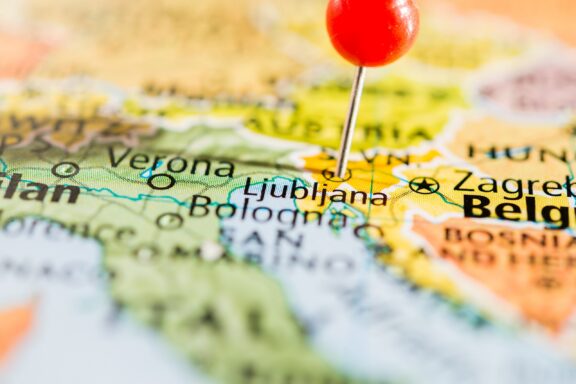
Ljubljana is located in the central part of Slovenia, a country in Central Europe. It’s positioned on the Ljubljanica River, approximately midway between Austria to the north and Croatia to the south. Slovenia also borders Italy to the west and Hungary to the east.
The central location of Ljubljana in Slovenia makes it a convenient base for exploring the rest of the country. It is approximately 46 kilometers (29 miles) from the Italian border, 102 kilometers (63 miles) from the Austrian border, and just over 100 kilometers (around 62 miles) from both the Hungarian and Croatian borders.
The geographical position of Ljubljana contributes to its cultural richness and diversity, being at a crossroads of Slavic, Germanic, and Latin cultures.
History of Ljubljana
The history of Ljubljana stretches back thousands of years, with its earliest settlers dating to around 2000 BC. It has seen a wealth of different cultures and powers influence its development over the centuries, and each period has left its mark on the city.
The area now Ljubljana was settled by people living in pile dwellings in the marshy regions around 2000 BC. These Prehistoric pile dwellings around the Alps, including those in the Ljubljana Marshes, are now a UNESCO World Heritage site.
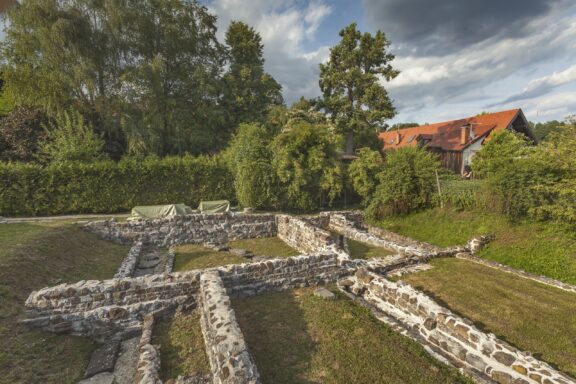
In the 1st century AD, the Romans established a military camp, which later grew into Emona. This city stood on the site of modern-day Ljubljana, and remnants of Roman walls and structures can still be seen today.
In the Middle Ages, Ljubljana came under the rule of the Habsburgs after periods of control by the Franks and Bavarians. During the Middle Ages, the city’s emblem, the dragon, became associated with Ljubljana, inspired by the legend of Jason and the Argonauts.
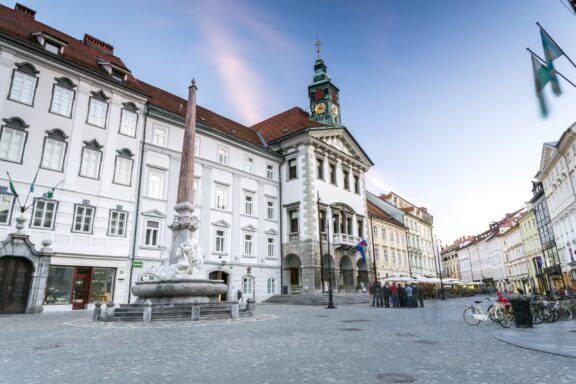
During the Renaissance period, Ljubljana saw significant development and began to take on the character of a modern city. Ljubljana Castle was rebuilt in the 15th century, and the city survived an earthquake and an Ottoman invasion.
In the 19th century, Ljubljana, influenced by nationalist movements across Europe, became a Slovene cultural and political activity center. The first Slovene book was published during this period, and the Slovene language became increasingly used in education and public life.
The 20th century was a period of significant change for Ljubljana. After World War I, it became part of the Kingdom of Yugoslavia. Fascist Italy occupied the city during World War II and was heavily bombed by the Allies, causing significant damage. After the war, it became part of socialist Yugoslavia and underwent extensive rebuilding and modernization.
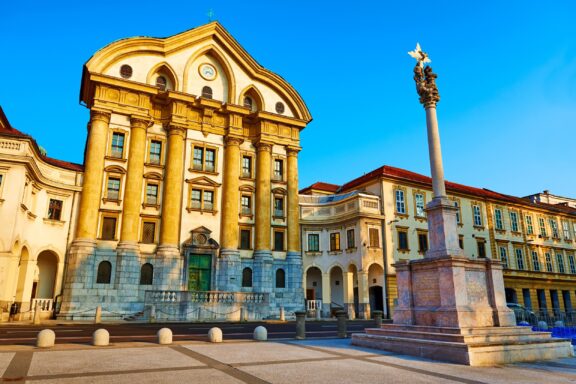
In 1991 Slovenia declared independence from Yugoslavia, and Ljubljana became the new nation’s capital. Today, it is a vibrant and cosmopolitan city known for its environmental commitment, having been awarded the title of European Green Capital in 2016. Its combination of historical heritage and progressive values makes it a fascinating place to visit or live in.
Features of Ljubljana
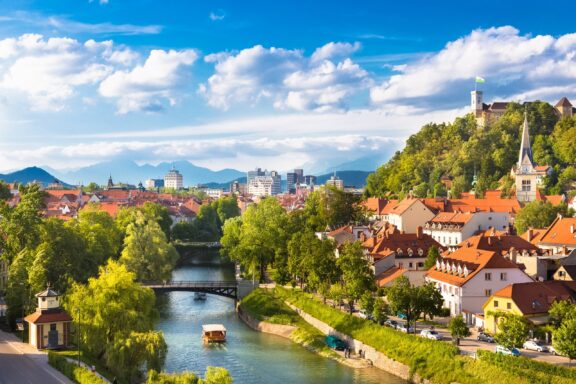
Ljubljana is a charming and vibrant city that captures its visitors’ hearts with the youthful energy and historical significance. Ljubljana is a city that marries tradition and modernity, offering a rich historical heritage, a thriving cultural scene, and a solid commitment to sustainable living, all set against Slovenia’s beautiful landscapes.
Geography and Climate
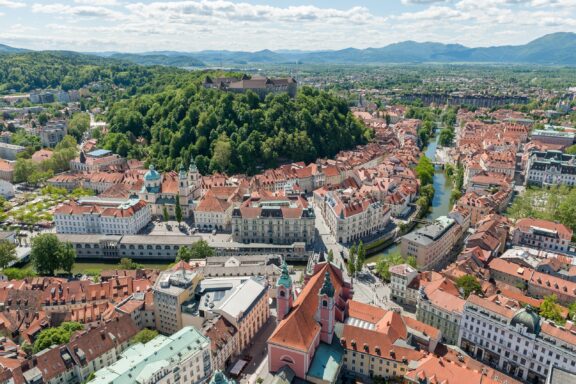
Geographically, Ljubljana sits in a basin surrounded by highlands to the south and flatlands to the north. This terrain is part of the broader Ljubljana Basin, between the Alpine and Dinaric landscapes. The Ljubljanica River, where the city is situated, is notable for its multiple sources and confluences. The river and its network of canals and tributaries significantly contribute to the city’s distinctive character.
Ljubljana experiences a temperate continental climate, with warm summers and cool to cold winters. The average temperature in the summer ranges from 20 °C to 25°C (68 °F to 77 °F), while in winter, temperatures usually range from -2 °C to 3 °C (28 °F to 37 °F). The city gets significant rainfall throughout the year, with the highest precipitation in autumn.
Population
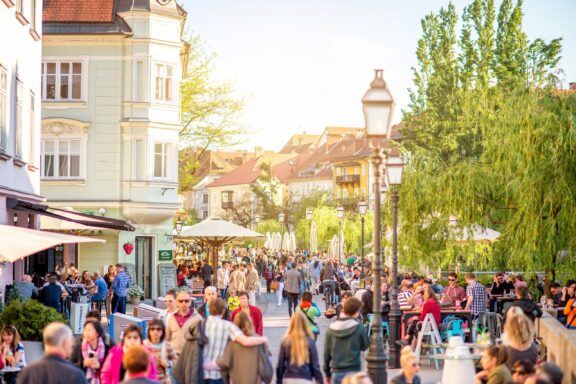
Ljubljana has a population of over 285,000, making it the largest city in Slovenia. The city is known for its diversity and is home to a mix of Slovenes and other nationalities, with the majority being Slovenes. The presence of the University of Ljubljana also brings in a substantial student population from all over the world, adding to the city’s vibrancy and cultural richness.
Slovene is the official language, but English is widely spoken, especially by younger people and professionals. The city is characterized by its friendly locals and a high standard of living.
Economy
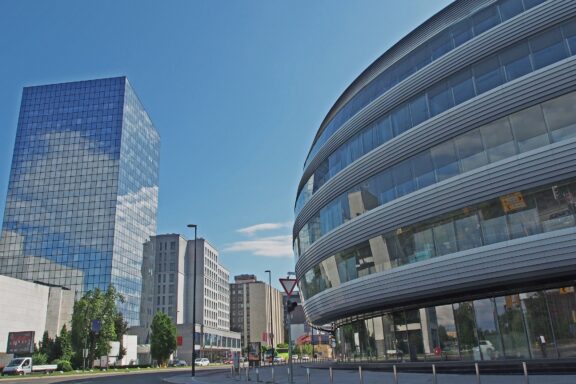
Ljubljana houses many government institutions contributing to its economy. Besides government, other major sectors include commerce, banking, transport, construction, business services, and tourism.
The city is also a significant hub for traditional and creative industries, housing numerous media and advertising agencies and design, architecture, and fashion firms. Its technology sector is growing, with many startups choosing to base themselves in the city.
Ljubljana’s location in the center of Slovenia makes it an important transport hub, with good road and rail connections to other European cities, contributing to its economic importance.
Tourism is also a significant part of Ljubljana’s economy, with the city’s historical charm, architectural beauty, and vibrant cultural scene attracting visitors worldwide. Moreover, Ljubljana’s recognition as the European Green Capital in 2016 has increased its appeal as a sustainable tourism destination.
Things to Do and Places to See in Ljubljana
Ljubljana offers an abundance of activities and sights for visitors to explore. Let’s delve into some of this captivating city’s most sought-after attractions and landmarks:
1. Ljubljana Castle
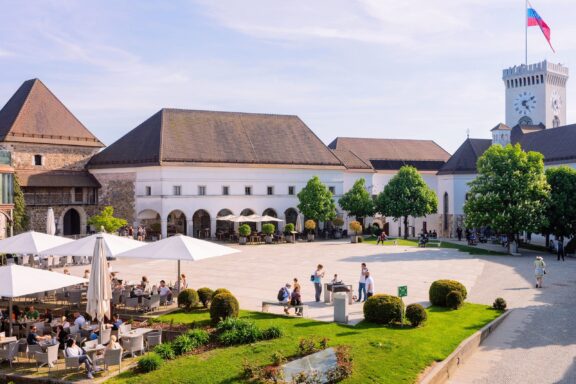
Ljubljana Castle is a key landmark and one of the most famous attractions in Slovenia’s capital city, Ljubljana. Perched atop a hill in the city center, it provides stunning panoramic views of Ljubljana and its surroundings.
Ljubljana Castle is built in various architectural styles due to its age and the many different functions it has served. It includes elements of Romanesque, Gothic, and Renaissance architecture.
Today, the castle is a major tourist attraction and a cultural venue. Visitors can take a funicular railway from the city center to the castle. Once there, they can explore the castle’s museums, galleries, and other attractions. The castle’s courtyard is also used for cultural events, such as concerts and theater performances.
2. Tivoli Park
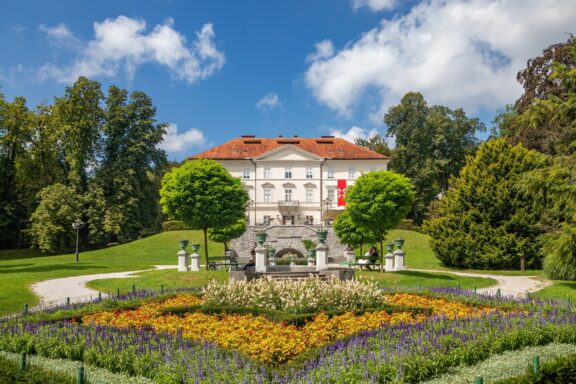
Tivoli Park is the largest and most beautiful park in Ljubljana. It covers approximately 5 square kilometers and’s an oasis of peace and greenery in the city center. The park was designed in 1813 by the French engineer Jean Blanchard, and it merges seamlessly with the slopes of Rožnik Hill.
Tivoli Park is more than just a green space; it’s also home to several notable landmarks and cultural institutions. These include the Tivoli Castle, the International Centre of Graphic Arts, the Tivoli Sports Hall, the Tivoli Greenhouse, and the Tivoli Pond.
Tivoli Park is also an essential part of the city’s cultural life. The park hosts several events throughout the year, including concerts, outdoor theatre performances, and art installations.
3. Preseren Square
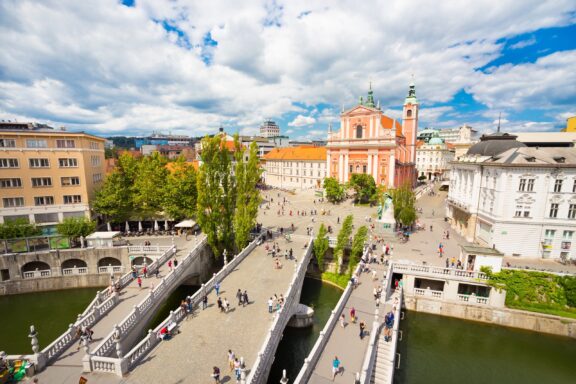
The square is notable for several iconic landmarks. At its center stands the Prešeren Monument, a statue of France Prešeren. This monument, unveiled in 1905, commemorates the poet’s significant contributions to Slovene literature and the Slovenian national identity. His poem “Zdravljica” (“A Toast”) is now the national anthem of Slovenia.
Prešeren Square is vital part of the city’s vibrant cultural and social life. Whether it’s to admire the architecture, attend an event, or sit and watch the world go by, a visit to Prešeren Square is a must for any visitor to Ljubljana.
4. Dragon Bridge
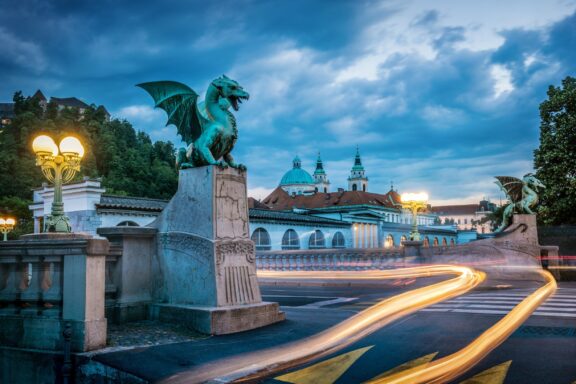
The Dragon Bridge spans the Ljubljanica River, connecting the Komensky Street (Komenskega ulica), located at the foothills of the Ljubljana Castle, with the Ljubljana Central Market (Osrednja Ljubljana Tržnica).
The bridge was originally named The Jubilee Bridge of Emperor Franz Josef I, in honor of the fortieth anniversary of Emperor Franz Joseph’s rule. Still, it quickly earned its popular name due to the four imposing dragon statues that guard the bridge at both ends.
The dragon is an important symbol in Slovenian folklore and the city’s coat of arms. It is believed to be based on the legend of Jason and the Argonauts; according to the story, Jason was the founder of Ljubljana, and he and his Argonauts killed a dragon. This is why the dragon is depicted on the Ljubljana Castle Tower and the city’s coat of arms.
5. Central Market
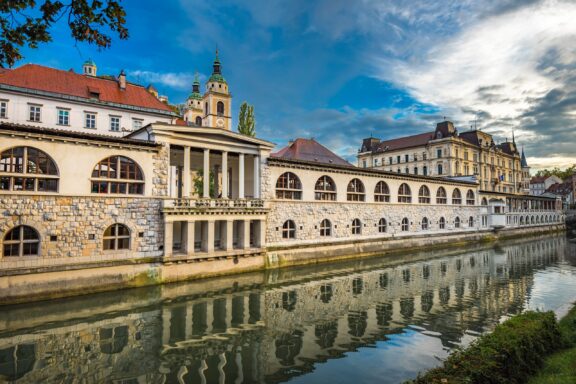
The Central Market consists of an open-air market, a covered market, and a series of small food shops along the river in a colonnade called the Market Colonnade or Plečnik’s Colonnade. These beautifully designed colonnades are a distinct market feature, providing a visual and functional element to the market area.
The market offers a wide variety of goods. In the open-air market, local farmers bring fresh fruits, vegetables, herbs, and flowers daily. The covered market, housed in the Plečnik’s Colonnade, offers dairy products, meat, baked goods, and other food products.
6. Church of St. Nicholas
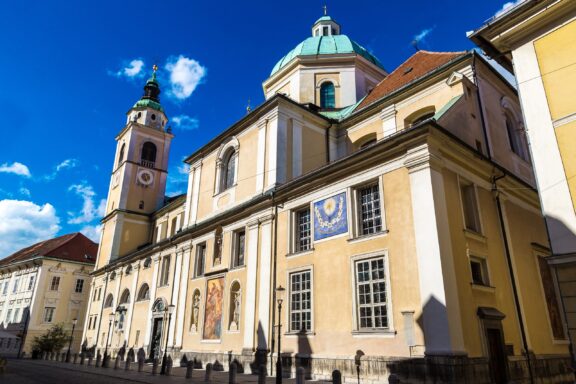
The Cathedral of St. Nicholas, or simply Ljubljana Cathedral, is a prominent landmark and an important religious site in Ljubljana. The current Baroque building was constructed between 1701 and 1706 on a former Gothic church site from the 13th century. It was designed by the Italian architect Andrea Pozzo, with the dome added later in 1841.
The cathedral’s exterior, with its green dome and twin towers, is an imposing sight. However, the interior is even more stunning, with richly decorated frescoes painted by the Slovenian painter Matevž Langus and the Italian artist Giulio Quaglio. The cathedral’s frescoes are considered one of its most remarkable features.
7. National Gallery
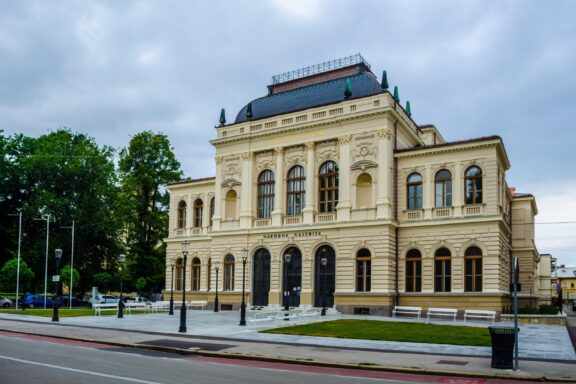
The National Gallery of Slovenia (Narodna Galerija) in Ljubljana is the leading art museum in Slovenia and one of the country’s most important cultural institutions.
The gallery is housed in a building initially constructed as an aristocratic mansion in the 19th century. In the 1990s, it underwent a significant renovation and expansion, connecting the mansion with a neighboring building to accommodate the gallery’s growing collection.
The National Gallery of Slovenia is not just a place to admire artworks but also an institution that conducts research, organizes educational programs, publishes art literature, and more. Its mission is to preserve and present Slovenia’s artistic heritage to the public and promote a deeper understanding and appreciation of the visual arts.
8. Boat tour on the Ljubljanica River
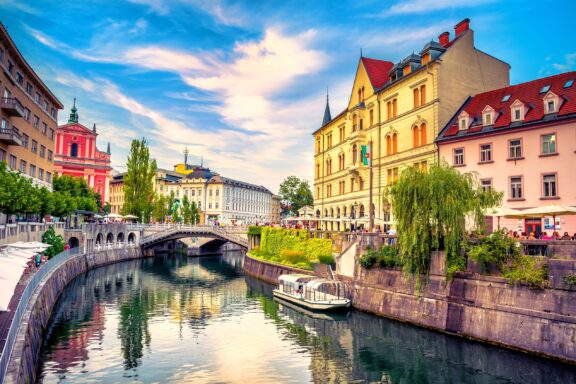
Several companies offer boat tours on the Ljubljanica, and most tours last 45 minutes to an hour. The tours are typically guided, with the guide providing interesting information about Ljubljana’s history, culture, and the landmarks you pass by. It’s a relaxed and enjoyable way to see the city, particularly on a nice day.
During the tour, you’ll pass by many of the city’s most notable sights. These include the Butchers’ Bridge, the Dragon Bridge, the Triple Bridge, and Plečnik’s Summer Theatre, as well as the colorful facades of the old city center. You’ll also get a great view of the Ljubljana Castle, perched on a hill overlooking the city.
9. Metelkova City
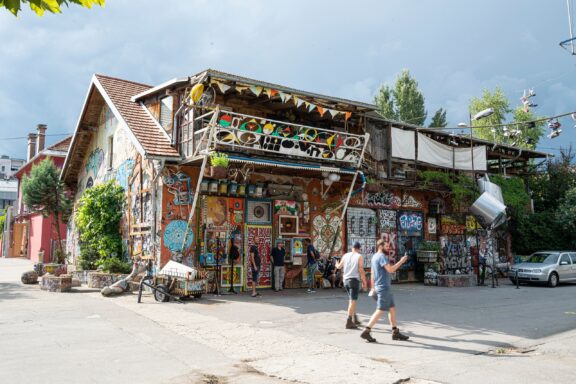
Metelkova City, often called Metelkova, is known for its alternative culture, creative atmosphere, and a hub for artists, activists, and alternative music.
The area is located on the site of former military barracks (initially built by the Austro-Hungarian army in the 19th century) abandoned during the Yugoslav period. After Slovenia gained independence in 1991, the vacant barracks were soon occupied by settlers who wanted to prevent the buildings from being torn down.
Since then, Metelkova has transformed into a lively cultural and autonomous social center of sorts, known for its distinct graffiti, unique sculptures, and colorful murals. It has numerous clubs, live music spaces, art galleries, and artist studios.
10. Old Town
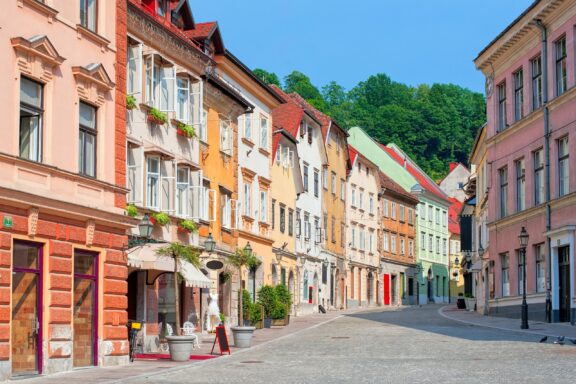
Ljubljana Old Town, nestled on the eastern bank of the Ljubljanica River, is the historical core of Ljubljana. Wandering through the Old Town’s cobbled streets, you’ll find a range of architectural styles from different periods, mainly Baroque and Art Nouveau, but also remnants of the Medieval period. This part of the city is filled with quaint cafes, top-rated restaurants, boutique shops, and various art galleries.
Ljubljana Old Town’s pedestrian-only streets and relaxed atmosphere make it a perfect area for strolling and exploring leisurely. It’s a vibrant and charming district where history and culture blend seamlessly with lively cafes and events. No visit to Ljubljana would be complete without spending time in the city’s Old Town.
11. Museum of Modern Art
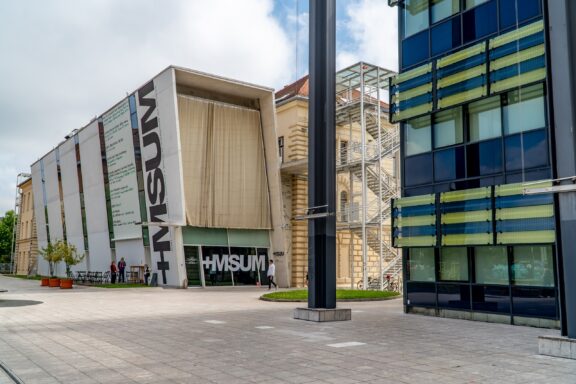
The Museum of Modern Art, also known as Moderna Galerija, in Ljubljana, is a museum that houses Slovenia’s national collection of 20th-century modernist art.
The museum’s collection includes works from various artistic movements of the 20th century, from avant-garde and post-war art to art of the late 20th century. It has pieces by the most influential Slovenian artists of this period and a selection of works by international artists.
12. The City Museum of Ljubljana
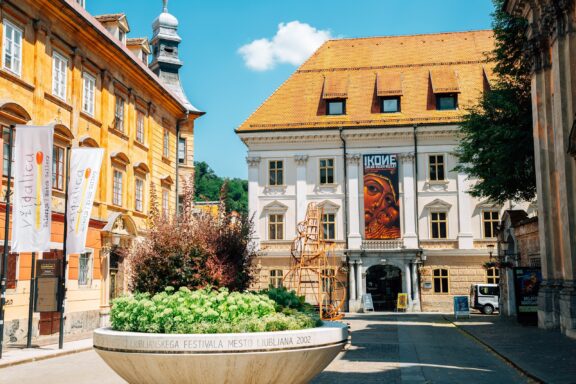
The City Museum of Ljubljana showcases Ljubljana’s history from prehistoric times to the present day. Its collections include archaeological finds, artworks, photographs, and other historical objects that tell the story of the city and its residents.
One of the museum’s most famous exhibits is the world’s oldest wooden wheel with an axle, dating back about 5200 years. Discovered in the Ljubljana Marshes, this incredible artifact testifies to the long history and technological advances of the city’s early inhabitants.
13. Krizanke Summer Theatre
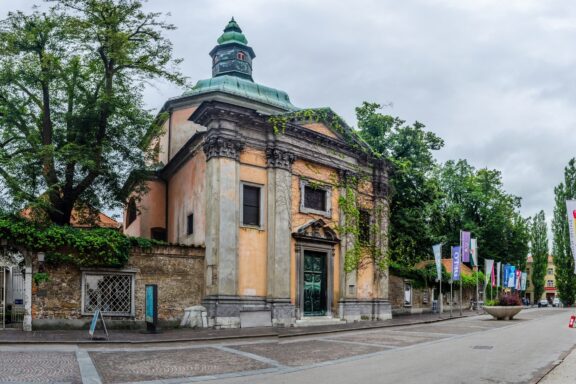
The Krizanke Summer Theatre is a popular outdoor venue in Ljubljana. It’s known for hosting various performances, including concerts, theatre productions, and dance performances, particularly during summer.
After World War II, the derelict monastic complex was transformed into a venue for the Ljubljana Summer Festival by the renowned Slovenian architect Jože Plečnik. The renovation, completed in 1956, preserved elements of the original Gothic and Renaissance architecture but added a unique touch characteristic of Plečnik’s style.
14. Šmarna Gora
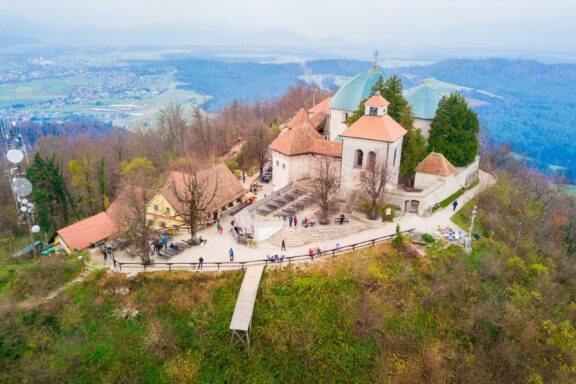
Šmarna Gora is a famous hill located in the northern part of Ljubljana. At 669 meters high, it’s the highest point in the city and a beloved local hiking spot. The trails leading up to the top are well-maintained and suitable for both casual walkers and more experienced hikers.
Once you reach the summit, you’ll be rewarded with panoramic views of Ljubljana and the surrounding countryside. The hilltop is also home to the Church of St. Mary, a historic chapel dating back to the early 16th century, and a restaurant where you can try traditional Slovenian dishes.
15. Ljubljana Zoo
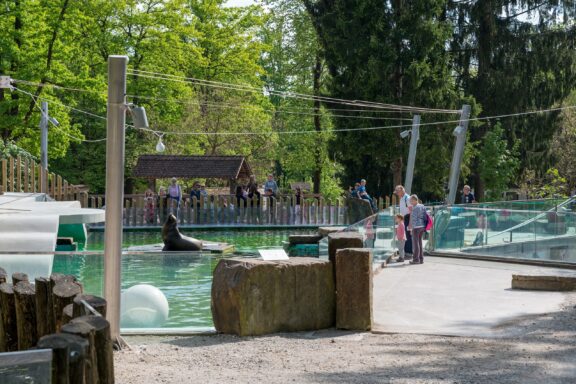
Located in the southern part of the city, in the woods of Rožnik Hill, the Ljubljana Zoo is the only zoological park in Slovenia. Covering about 20 hectares, the zoo is home to over 500 animals representing about 120 species, including various birds, mammals, and reptiles.
The Ljubljana Zoo is well-known for its efforts in conservation and education. It’s involved in several European conservation programs and offers a variety of educational programs and events for children and families. The zoo allows visitors of all ages to learn about animals, their habitats, and the importance of conservation.
Frequently Asked Questions
What is the best time to visit Ljubljana?
The best time to visit Ljubljana is in the spring (April to June) and early autumn (September and October) when the weather is mild, and the city is not as crowded as in the peak summer months. The city is also beautiful in December when it’s festively decorated for Christmas.
Is it safe to visit Ljubljana?
Yes, Ljubljana is generally considered safe for tourists.
What is traditional food and cuisine like in Ljubljana?
The cuisine in Ljubljana is diverse due to Slovenia’s geographical location, with influences from Italy, Austria, Hungary, and the Balkans. Traditional Slovenian food is hearty and often includes dishes like:
• Potica (rolled pastry with various fillings)
• Kranjska klobasa (Carniolan sausage)
• Žganci (buckwheat spoonbread)
• Kremšnita (cream slice pastry).
What souvenirs can I bring home from Ljubljana?
Popular souvenirs from Ljubljana include:
• Honey or products made from honey (Slovenia is known for its beekeeping)
• Local wines
• Handmade lace
• Unique Slovenian arts and crafts available at the
• Central Market
How can I get around in Ljubljana?
Ljubljana is a compact city, so getting around on foot is easy. There’s also an efficient public transport system, with buses being the primary mode of public transportation. You can use the city’s bike-sharing program, BicikeLJ, for more sustainable travel.
Is it expensive to visit Ljubljana?
Compared to many other European capital cities, Ljubljana is relatively affordable. Accommodation, dining, and entertainment options exist for a range of budgets. However, prices can rise during peak tourist season.
Which currencies are accepted in Ljubljana?
The official currency of Slovenia is the Euro (€). Credit cards are widely accepted, and ATMs are readily available.
Is Ljubljana a good city to live in?
Yes, Ljubljana is often rated highly for its quality of life. It’s a clean, green, and safe city with a rich cultural scene, friendly locals, good healthcare and education systems, and a lower cost of living than many other European cities.
Is it safe to drink tap water in Ljubljana?
Yes, tap water in Ljubljana is clean and safe to drink.
Are locals friendly in Ljubljana?
Yes, locals in Ljubljana are generally friendly, hospitable, and helpful to visitors. Many speak English, making it easier for tourists to communicate.
How can I respect the local culture and environment during my visit in Ljubljana?
To respect the local culture, try to learn a few words in Slovene, and show interest in local traditions and customs. Respect public spaces and don’t litter – Ljubljana is known for being a green and clean city. Using public transport, cycling, or walking instead of driving can also help reduce your environmental impact.
Final Thoughts
Ljubljana is unquestionably worth a visit for any traveler seeking a unique and enriching experience. As Slovenia’s capital, it offers a harmonious blend of history, culture, and modernity. Its picturesque cityscape, from the castle-topped hill to the charming bridges over the Ljubljanica River, creates a fairy-tale setting that enchants visitors.
The city’s bustling markets, impressive culinary scene, and vibrant cultural life add to its appeal. It is also celebrated for its commitment to sustainability, reflected in its efficient public transport, bike-friendly streets, and extensive green spaces. Overall, Ljubljana offers a high quality of life and a warm, welcoming atmosphere that leaves a lasting impression on those who visit.
Image Sources and Copyright Information
- image-95: © Mappr
- Pinpointing Ljubljana on a Map: © Tudoran Andrei/Shutterstock
- Ancient Stone Ruins Amidst Greenery: © Cortyn/Shutterstock
- Ljubljana Town Hall and Square: © Sopotnicki/Shutterstock
- Baroque Church and Column Monument under Blue Sky: © Truba7113/Shutterstock
- Ljubljana Cityscape with River and Castle: © Matej Kastelic/Shutterstock
- Aerial View of Ljubljana Cityscape with River: © MilanTomazin/Shutterstock
- Bustling Street Scene in Ljubljana Old City Center: © RossHelen/Shutterstock
- Ljubljana Business District with Modern Buildings: © Gasper Grubelnik/Shutterstock
- Sunny Day at Ljubljana Castle Courtyard with Visitors: © Roman Babakin/Shutterstock
- Baroque Mansion Surrounded by Gardens and Statues: © brunocoelho/Shutterstock
- Triple Bridge and Prešeren Square in Ljubljana: © Matej Kastelic/Shutterstock
- Dragon Bridge at Twilight with Light Trails: © Triff/Shutterstock
- Ljubljana Central Market by the River: © javarman/Shutterstock
- Baroque Cathedral Facade under Blue Sky: © Sergii Figurnyi/Shutterstock
- Exterior View of the National Gallery of Ljubljana: © trabantos/Shutterstock
- Boat on the Ljubljanica River with Cityscape: © Georgios Tsichlis/Shutterstock
- Urban Art and Graffiti on Building at Metelkova: © Sergio Delle Vedove/Shutterstock
- Ljubljana Old Town Street View: © Boris Stroujko/Shutterstock
- Exterior View of Modern Art Museum: © JackKPhoto/Shutterstock
- City Museum of Ljubljana Exterior View: © Sanga Park/Shutterstock
- Križanke Summer Theatre Exterior View: © trabantos/Shutterstock
- Aerial View of a Hilltop Church and Surrounding Landscape: © Uros Stepisnik/Shutterstock
- Visitors Watching Sea Lion at Zoo Enclosure: © Bizi88/Shutterstock